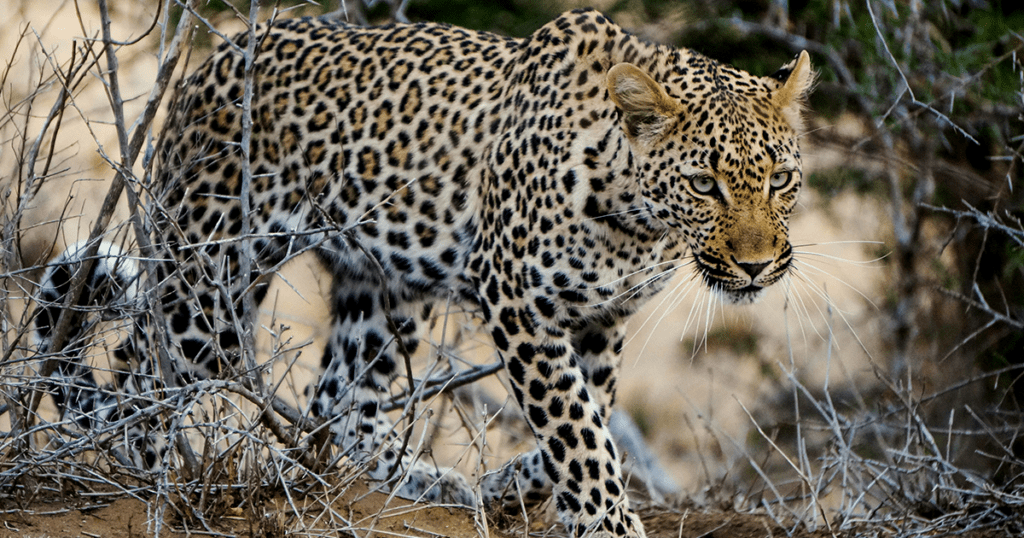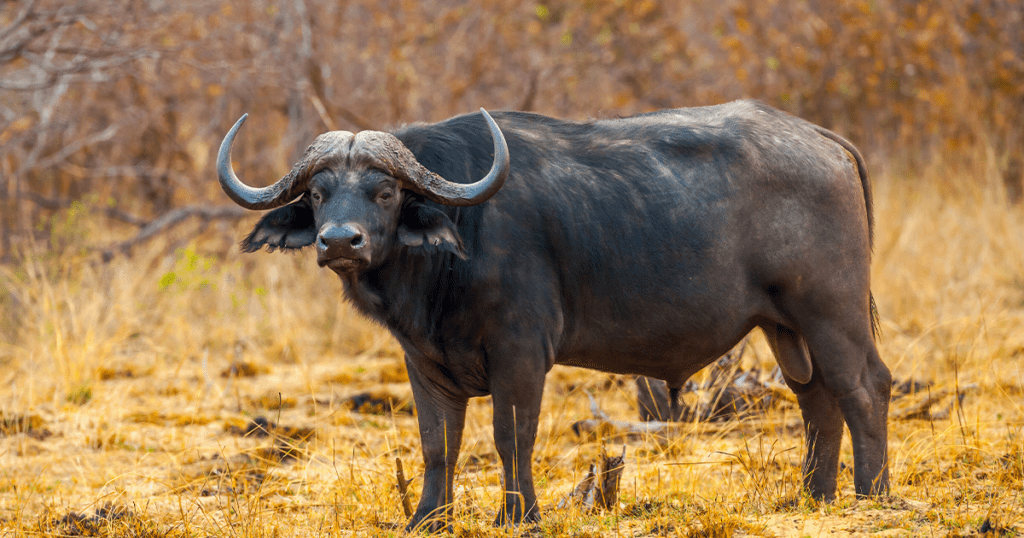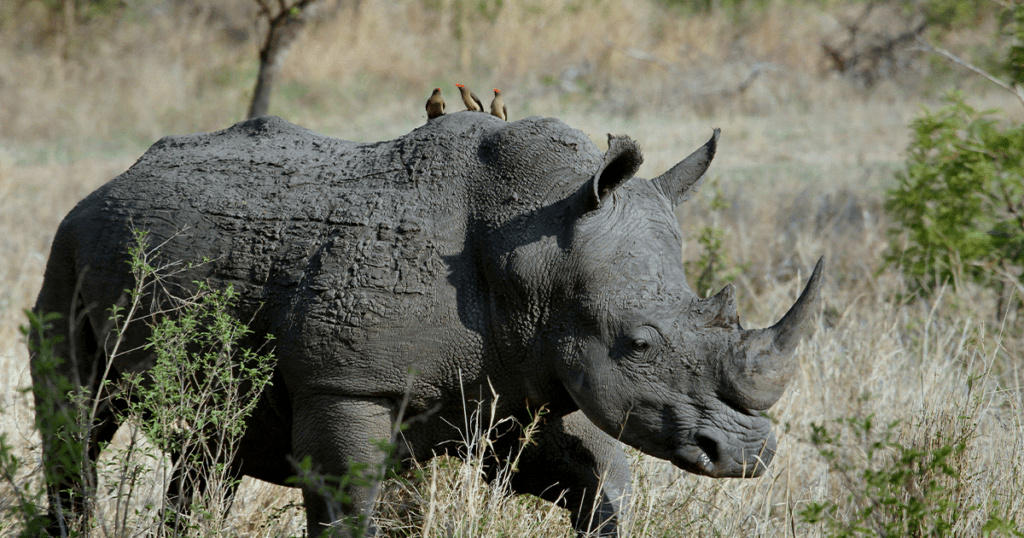
Discover Africa’s Most Iconic Wildlife – The Big Five
- byscarfacepride
- - July 8, 2024
Home » Blog » Discover Africa’s Most Iconic Wildlife – The Big Five
Ask any safari enthusiast who’s planning a safari in East Africa, and they’ll say their ultimate goal is to encounter the legendary Big Five – stately lions, swift leopards, mighty elephants, rare rhinos, and brawny buffaloes.
What makes these creatures remarkable? Let’s delve deeper into their world, explore their unique characteristics, ecological roles, and the best ways to witness them in their natural habitats!
The King of the Jungle: The Lion

Imagine seeing a pride on the hunt in the middle of the great plains, as you observe, just a couple feet away from them. Their lustrous mane, thunderous roar, and massive muscles rippling as they stalk their prey – it’s a majestic breathtaking experience! These apex predators hunt antelopes, zebras, and wildebeest using a combination of stealth and teamwork.
His lustrous, flowing mane is a symbol of strength and authority. The lion, with its thunderous roar that can be heard up to five miles away.
Lions live in prides, which are social groups made up of related females, cubs, and one or two males They are highly social animals, with complex social structures within prides. Females are the heart of the pride, responsible for nurturing cubs and preserving social order. Males, on the other hand, are migratory and compete for the opportunity to command a pride. Observing interactions among a pride, from playful cubs battling with one another to excited greetings between lionesses, provides insight into the complex social lives of these majestic animals.
Where can you find them?
Masai Mara National Reserve (Kenya):
This world-renowned reserve is part of the Serengeti-Mara ecosystem and boasts one of Africa’s largest lion populations. The Mara Triangle, a conservancy within the reserve, is well-known for its high lion sightings.
Serengeti National Park (Tanzania):
The Serengeti’s vast grasslands are another excellent place to observe lions, particularly during the Great Migration when prey is plentiful. While not a conservancy, the park has a long history of wildlife conservation and is a UNESCO World Heritage Site.
Kruger National Park (South Africa):
This vast park is home to a sizable lion population, with places such as the Sabi Sand Game Reserve recognized for good lion spotting. Many private reserves bordering Kruger provide fantastic opportunities to see lions in a more intimate setting. They focus on wildlife conservation and anti-poaching initiatives.
Witness the power and grace of lions in their true glory yourself, plan your safari with Scarface Pride!
The Elusive Hunter: The Leopard

From one apex predator to another, now we meet the leopard, with its spotted coat that provides excellent camouflage, is a solitary predator renowned for its agility and stealth. Leopards, unlike lions, are adept climbers and frequently hide their food high in trees, protecting it from scavengers. They are opportunistic hunters who prey on a wide range of species, including gazelles, monkeys, tiny reptiles, and birds.
Leopards are primarily nocturnal, with most hunting taking place between sunset and dawn. Spotting a leopard during the day is a rare occurrence, but with a keen eye and a knowledgeable guide, you might get a glimpse of one lazing in the sun on a rocky outcrop or chasing its prey through thick grass. It could be you, intently staring through your binoculars, spotting the rare sight of a leopard hunting, an incredible display of athleticism and precision.
Where can you find them?
Sabi Sand Game Reserve (South Africa):
Situated on the western edge of Kruger National Park, Sabi Sand is world-renowned for its spectacular leopard sightings. Decades of research and anti-poaching initiatives have resulted in a habituated leopard population, giving tourists the opportunity to observe these elusive cats up close.
Central Kalahari Game Reserve (Botswana):
The vast Kalahari landscape provides an exceptional opportunity to observe leopards adapting to a drier climate. Conservation efforts in the Central Kalahari are centered on protecting this endangered ecosystem and its animals.
Leopards may be elusive, but the experience of witnessing one in the wild yourself is unparalleled. Let Scarface Pride plan your meet and greet with these spotted cats for you!
The Gentle Giant: The Elephant

Displays of ferocity aren’t rare among the Big Five, but an exception among these is this colossal creature. Bigger than them all – the world’s largest land animal, with males standing up to 13 feet tall and weighing an astonishing 7 tons, but compassionate one as well. While the rest rank high on vigor, the elephant is the most emotionally intelligent. These gregarious creatures live in herds governed by knowledgeable, experienced females known as matriarchs. Elephants are herbivores, spending much of their time grazing on grasses, leaves, and fruits. Their intellect and social bonds are extremely impressive.
Elephant herds are complex social units, with strong bonds between females and their offspring. Matriarchs play a crucial role in leading the herd, teaching younger elephants about finding food and water, navigating their environment, and avoiding danger. You can witness the playful interactions between young calves and the nurturing behaviour of adult females, a heartwarming glimpse into the deep family ties that bind these mighty creatures. This sight is only a safari plan with us away.
Where can you find them?
Addo Elephant National Park (South Africa):
This park is a sanctuary for elephants, with the highest concentration in South Africa. Addo’s conservation efforts are centered on habitat restoration and anti-poaching initiatives, guaranteeing a safe environment for these gentle giants.
Tarangire National Park (Tanzania):
Known as the “Elephant Paradise,” Tarangire is home to vast herds of elephants that congregate around the park’s permanent watering holes during dry season. Conservation activities in this area are centered on conserving elephant migratory corridors and other species.
Meet these gentle giants yourself, leave the planning to us.
The Most Unforgiving: The African Buffalo

Another iconic giant from the African continent, the Buffalo is a powerful herbivore with a solid reputation. These stocky creatures, often called “Cape buffalo” due to their historical abundance in South Africa’s Cape Province, live in herds and are notorious for their aggressive temperament, particularly when threatened. Despite their size, they are remarkably agile and can outrun most predators.
In the ecosystem of the African savanna, buffalo are essential. By creating a mosaic of habitats for various animals, their grazing practices contribute to the upkeep of healthy grasslands. Additionally, they provide as essential source of prey for crocodiles, lions, and leopards, maintaining a healthy predator-prey relationship. A buffalo herd’s significance in the cycle of life becomes apparent when you see them grazing calmly across the savanna or defending themselves against an attack by a predator.
Yes, you can see this yourself. All you have to do is reach out to us!
Where can you find them?
Masai Mara National Reserve (Kenya):
This world-famous reserve is part of the larger Serengeti-Mara ecosystem and is home to a variety of wildlife, including large herds of cape buffalo.
Serengeti National Park (Tanzania):
The vast plains of the Serengeti are another prime location for spotting buffalo. These hardy animals play a vital role in the ecosystem, and their grazing patterns help maintain the health of the grasslands.
The Endangered Icon: The Rhinoceros

The rearrest jewels in Africa’s wildlife crown, the black rhinoceros and the white rhinoceros are the two species of rhinos. Unfortunately, poaching for their horns—which are falsely thought to have medicinal properties has led to the classification of both as endangered. They are large, lone grazers with remarkable horns and thick skin.
While white rhinos graze on broad grasslands, black rhinos are smaller and prefer to forage in thickets and woodlands. For these amazing animals to survive, conservation efforts are essential. Even from a distance, witnessing a rhino in the wild serves as a powerful reminder of the delicate balance of the natural world and the significance of safeguarding endangered species. The rare sight of these majestic rhinos is only a safari ride with us away!
Where can you find them?
Hluhluwe-iMfolozi Park (South Africa):
This UNESCO World Heritage Site is a huge success story in black rhino conservation. Despite being on the verge of extinction, black rhino populations in Hluhluwe-iMfolozi have revived because to stringent preservation efforts. Seeing a black rhino here demonstrates the power of conservation efforts.
Lewa Wildlife Conservancy (Kenya):
This private conservancy is a leader in rhino conservation, particularly for black rhinos. Lewa has a strict anti-poaching policy and actively contributes to research and breeding programs for black rhinos. Seeing a rhino here supports these vital efforts.
The Fight for Survival: Conservation Status of the Big Five
While some of the Big Five populations are showing signs of recovery, others face significant threats. Habitat loss, poaching, and human-wildlife conflict are major concerns. Responsible tourism plays a vital role in conservation efforts.
| ANIMAL | THREATS | CONSERVATION EFFORTS | ORGANISATIONS | STATISTICS |
| Lion | Habitat loss, conflict with humans, trophy hunting | Anti-poaching patrols, community outreach programs, research on lion populations | Panthera, Wildlife Conservation Society (WCS), Lion Guardians | * Less than 20,000 lions remain in Africa, a decline of over 40% in the last two decades. (Panthera) |
| African Elephant | Poaching for ivory, habitat loss, human-elephant conflict | Anti-poaching initiatives, education campaigns, research on elephant behavior and migration | International Fund for Animal Welfare (IFAW), World Wildlife Fund (WWF), African Elephant Coalition | * Around 415,000 elephants remain in Africa, but populations are declining at an alarming rate. Poaching for ivory is a major threat. (WWF) |
| Rhinoceros | Poaching for horns, habitat loss | Intensive anti-poaching patrols, rhino relocation programs, breeding programs in sanctuaries, | African Rhino Specialist Group, Black Rhino Range States Committee, Lewa Wildlife Conservancy, WWF, International Rhino Foundation (IRF), South African National Parks | * Critically endangered, with only around 5,600 black rhinos remaining. Poaching for horns used in traditional medicine is a major threat. While not critically endangered like black rhinos, white rhino populations still face threats. Around 20,000 white rhinos remain in Africa. |
| African Buffalo | Habitat loss, competition with livestock, diseases | Disease control programs, habitat restoration initiatives, monitoring populations | IUCN SSC Antelope Specialist Group, Buffalo Resource Center | While not classified as endangered, buffalo populations are impacted by habitat loss and disease. Their role in the ecosystem is crucial. (Buffalo Resource Center |
Beyond the Big Five: Other Safari Delights
While the Big Five are a major draw, Africa’s wildlife is incredibly diverse. Look out for cheetahs, giraffes, zebras, and even endangered animals like black rhinos, African wild dogs, cheetahs, different species of antelopes, and countless other fascinating creatures on your safari. If you choose to travel from July-September, you can even witness the awe-inspiring wildebeest migration in the Masai Mara, a natural spectacle unlike any other.
FAQs:
Where is the best place to see the Great Migration?
Masai Mara National Reserve (Kenya): This world-famous reserve is part of the larger Serengeti-Mara ecosystem and boasts dramatic river crossings by wildebeest during the July-October period.
Serengeti National Park (Tanzania): The vast plains of the Serengeti offer year-round opportunities to see the migration in different stages. Witnessing the calving season (January-March) or the herds grazing on the short grasses during the dry season (May-July) are incredible experiences.
How do you witness the Great Migration?
The best way to witness the Great Migration is through a guided safari tour in either the Masai Mara or Serengeti National Park, depending on the time of year you visit.
Which is better Serengeti or Masai Mara?
Both locations offer incredible opportunities to see the Great Migration, but there are some key differences:
- Serengeti: Offers a larger area to explore and the chance to see the migration year-round. You might encounter fewer crowds outside the peak season (July-October).
- Masai Mara: Smaller reserve with more concentrated wildlife viewing, especially during the dramatic river crossings. Expect higher visitor numbers during peak season.
Is seeing the Great Migration worth it?
Seeing the Great Migration is a truly unforgettable experience! Witnessing millions of animals on the move is a powerful reminder of the wonders of nature.
Ready to witness these majestic creatures yourself? Let Scarface Pride plan your safari for you!
Embark on an unforgettable African adventure and experience the thrill of spotting the Big Five in their natural habitat. Contact Scarface Pride today to start planning your dream safari and create memories that will last a lifetime.
